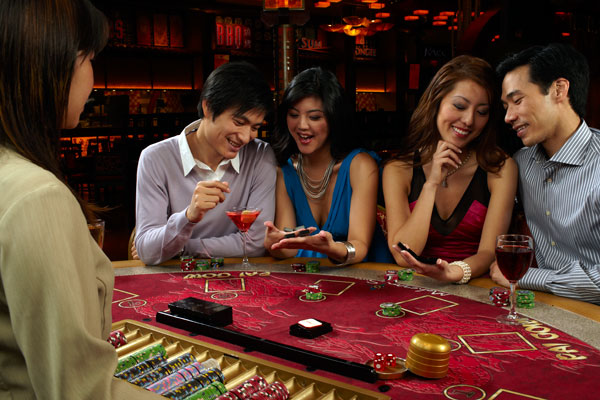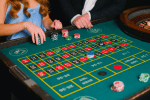Three Mysterious and Exotic Casino Card Games You Should Not Play
By Margie Pignataro © 2017 Great Bridge Links
I clearly remember the first time I encountered Pai Gow. It was last summer, and I was at the Aria. My husband was playing in a poker tournament. I decided to spend the hours wandering the Aria, getting overpriced coffee, staring at the sumptuous and surreal décor. I was crossing from one end to the other and passing a line of tables on my right. They were the size of blackjack tables so I assumed they were just that. In casinos, I always watch the gambling, whatever it is. I always stare. It’s something I developed in childhood, when my trips through casinos were fast walks and consisting only of envious, curious staring.
This time, while staring, I saw and heard something I never encountered before. I saw a dealer with a stack of rectangular chips, narrower and longer than playing cards, spreading them over the table and mixing them up as a child would. They had markings on them that made me think of Mah Jong pieces. They were the same creamy color, too. The clinking of the polished, clay chips was bizarre to me: there are no clicking sounds like this in a Vegas casino. It was one of the moments when I wasn’t sure for a split second where I was. Vegas was changing so much, nearly month to month. I was standing in a Casino that I remembered as once being a massive, irritating hole in the ground on Las Vegas Boulevard. Construction had turned the sidewalks into narrow wooden tunnels, nothing that hundreds of drunk Vegas vacationers could navigate comfortably.
I explained it to my husband on one of his breaks, and he was less than passively interested. All he offered was that the game was probably, “Something from China.” Next time I passed the tables I did the obvious thing that hadn’t occurred to me before. I read the signs above the table.
It was Pai Gow. I remember the name because of the Commerce Casino in Los Angeles. When they opened during my early college years, they offered Pai Gow Poker. I was so surprised that a casino was opening in Los Angeles that I let the dazzling, mysterious, Eastern Pai Gow Poker wash over me in a comfortable amazement.
Pai Gow Poker isn’t actually Eastern at all. It’s a derivative of Pai Gow, and it, along with other non-American card games are taking casinos by storm. They are all the rage, but they are also the most unappealing games for a smart, wary gambler.
I begin my discussion of these games with this warning: Do Not Gamble on These Games.
Pai Gow
Pai Gow can be considered a card game, though the cards used are “three-dimensional” (as the Aria Gaming guide puts it) or dominoes. It dates to the Song Dynasty in China, which occurred between 960-1279. This is roughly when Europe was going through its Dark or Middle Ages (depending how optimistic you want to be).
According to Wikipedia, Pia Gow is played “in major casinos in China (including Macau); the United States (including Las Vegas, Nevada; Reno, Nevada; Connecticut; Atlantic City, New Jersey; Pennsylvania; and cardrooms in California); Canada (including Edmonton, Alberta and Calgary, Alberta); Australia; and, New Zealand.”
The Aria gaming guide has a nice little description of play. It occurs with 32 dominoes and three dice:
“The dealer shuffles the dominoes and then rolls three dice. The total of the dice determines which player receives the first set of dominoes. Four dominoes are dealt to each player, each vacant player position on the table and to the dealer. Each player creates two hands with the four dominoes, a high hand and a second high hand. The object of the game is to create two hands which are both higher than the bank hands. If both hands are higher than the bank hands, the player wins. If one hand is higher and the other is lower, it is a tie. If both of the player’s hands are lower than the bank hands, the player loses.”
According to what I’ve read, this is a very difficult game to play.
Pai Gow Poker
Pai Gow uses a normal 52 card deck plus one joker. The game was developed by Sam Toroson in 1985 at the Bell Card Club in California. He wanted to create a variation of Pai Gow using cards which would be easy for Americans to learn. And it was. It swept through casinos coast to coast.
Each player is dealt seven cards. The object is to form two poker hands which will beat the dealer, a five card and a two card.
But what about the return on your money? This game is different from poker in that players play against the house and the house always has an edge.
From the Odds Shark:
“The Pai Gow house edge playing…is 2.84%. Most of that edge (1.27%) comes from players losing a tie to the bank. The rest comes from the 5% commission that’s paid on winning hands.”
What this means every time you bet, you lose 2.84% of your money. It goes to the house. And when you win, you pay 5% to the house of your win. According to this, you cannot break even. This is an unwinnable game.
Baccarat
The Aria guide refers to Baccarat as “the grandest of all casino games”. To me, Baccarat is always the game of James Bond. The people who play it are rich and evil, always in tuxedos and diamond studded dresses, and the fate of the world can change in one esoterically played hand.
There are three forms of Baccarat, and the one played in North American casinos is called punto banco. To make thing simple, it’s referred to in casinos as Baccarat. The game is played with six to eight decks of cards shuffled in a shoe. Players bet on either the player’s hand or the bank’s. The shoe is passed around the table and players deal the cards, two each. The winner is the hand which gets closest to nine. The game is, of course, more complicated than this explanation, and there are many much more detailed, confusing explanations on Baccarat available online.
Now the bad news: Baccart is structured around luck. Winning is entirely dependent upon the draw of cards. No skill is involved. The house always has the advantage and the house edge is never lower than one percent. Baccarat is such a money maker that in 2014, Macau casinos made 91% of their total income with Baccarat alone. See the Baccart Wiki here.





